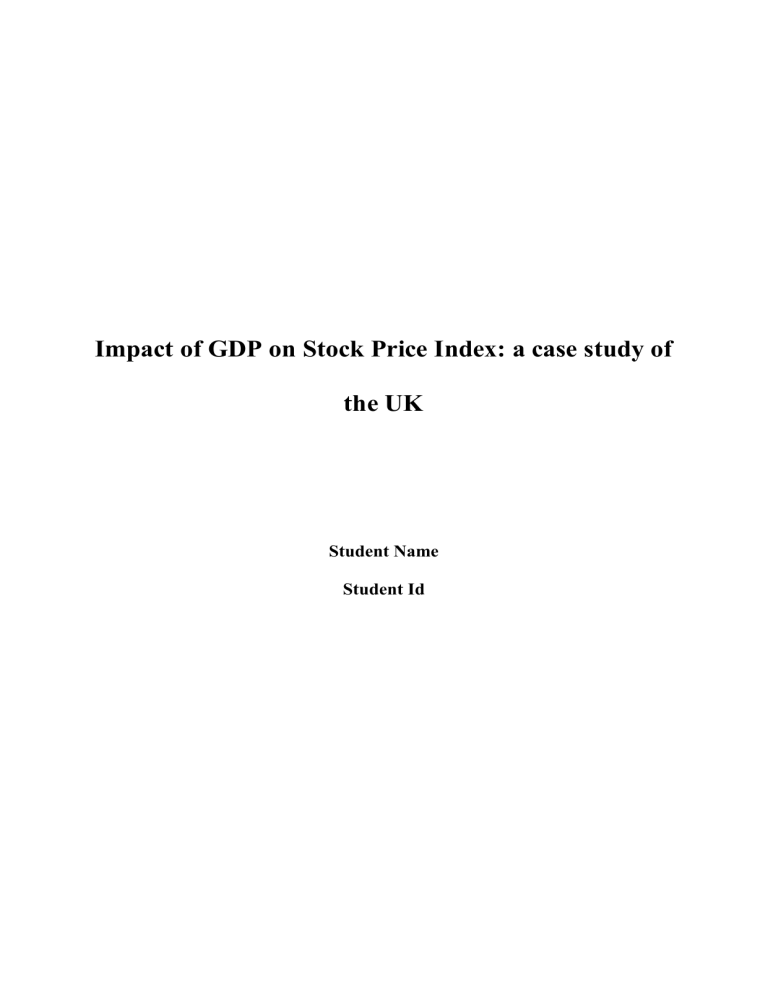
Impact of GDP on Stock Price Index: a case study of the UK Student Name Student Id Table of Contents 1.0 Introduction .......................................................................................................................... 3 2.0 Background of Study ........................................................................................................... 3 3.0 Data and Methodology ......................................................................................................... 4 4.0 Analysis and Discussion ...................................................................................................... 5 4.1 Descriptive Statistics Analysis ......................................................................................... 5 4.2 Inferential Analysis .......................................................................................................... 6 5.0 Conclusion ........................................................................................................................... 8 Reference ................................................................................................................................... 9 1.0 Introduction The stock price will increase or decrease depending on how much demand there is for it; this is how the stock market fluctuates. Like other economic indicators, the gross domestic product grows whenever individuals, companies, and governments show demand by increasing spending (Forbes.com, 2022). It has been seen that GDP declines as consumption declines. That is why the stock market and the GDP go hand in hand. Understanding GDP is essential to follow the stock market in real-time or predicting where it will go.The stock market fluctuates in response to demand; stock prices rise directly to demand and vice versa (Forbes.com, 2022). Like other economic indicators, GDP increases as governments, firms, and consumers spend more money (Demir, 2019). GDP falls when expendituredecelerates. As a result, the stock market and GDP are inextricably linked. Understanding GDP is critical if the goal is to track the stock market in real-time or predict where it will go. This current study aims to evaluate the impact of GDP on the UK stock market index. The study applies statistical analysis techniques such as descriptive and inferential statistics, including correlation and regression analysis, to shed light on the chosen topic. 2.0 Background of the Study Gross domestic product (GDP) determines whether the economy is expanding or contracting. The two methods to calculate the GDP: are expenditure and income. Expenditure GDP considers all spending on goods and services, including spending by individuals, corporations, and the government (Forbes.com, 2022). This figure also includes our imports and exports. Income-based GDP considers all income, including wages, profits and capital gains. To obtain an accurate GDP figure, depreciation and sales tax adjustments are frequently made (Demir, 2019). The figures are adjusted for inflation in both cases, and the resulting figure is referred to as real GDP. According to Chung et al. (2021), because prices naturally rise over time, failing to account for inflation skews the calculations, making it difficult to determine whether the economy is expanding or contracting. GDP is calculated annually, published quarterly, and in a year-end report. Further, the study has also concluded that it is critical to understand that the gross domestic product is a late indicator of the state of the economy because the final indicator for a given quarter is revealed only a month after the quarter ends (Chung et al., 2021). A stock market index, also known as a stock index, is a statistical measure of market changes. Grouping similar shares form it from among securities listed on the stock exchange, with the selection criteria being company size, market value, or type of activity.According to Demir(2019), the change in the prices of the target securities affects the index's total value. If prices rise, the index rises, and if they fall, the index will also fell. Stock indices are required to know the market sentiment. As an investor, by looking at the indices, you can identify the pattern of the market and decide which stocks can turn out to be a winning bet (Huyet al., 2021). In addition to helping you zero in on stocks when investing, indexes are a barometer for peer comparison. If a stock has outperformed the index, it is said to have outperformed. On the other hand, when it produced lower yields, it probably performed worse. Stock indices also help identify trends in a particular industry and make investment decisions accordingly(Datet al., 2020). They also help make passive investing, i.e., in a portfolio of securities that is very similar to an index. By investing passively, you can reduce the cost of the stock research and selection process.As the gross national product increases, corporate profits increase, leading to an increase in inventories. 3.0 Data and Methodology The study considers the monthly GDP of the UK (seasonally adjusted) (Fred, 2022). At the same time, the FTSE100 index is considered the stock market index (Investing, 2022). The researcher also considered inflation rate data as confounding variable for this study (UK historical inflation rates - 1988 to 2022). Data were extracted from several data sets to compile in one single data set. In this data set, there are 253 observations in total. There are three attributes, i.e., date, price and Gross Domestic Product (GDP). The dates run from February 1, 2001, to February 1, 2022. This case study's main aim is to analyse GDP's impact on the Stock Price Index. For that reason, the Stock Price Index is the dependent variable, and GDP will act as the independent variable. The necessary statistical analysis or tests are performed using the STATA statistical software application. The following tests are performed for the study: 1. Descriptive Statistics. 2. Pearson's Correlation test. 3. Regression Analysis. 4.0 Analysis and Discussion 4.1 Descriptive Statistics Analysis A descriptive statistical test has been conducted on the STATA software application. Two variables, price and Gross Domestic Product, were chosen from the data set for descriptive statistical analysis. It can be observed from the following results that the total number of observations in the data set was 253. The mean or the average stock price over the years was 5936.28, which is about 5936, and the mean of GDP was 99.67, which is about 100, from February 1, 2001, to February 1, 2022. In these years, the minimum and maximum marks in the variable price were 3567.4 and 7748.76, respectively. On the other hand, the minimum and maximum for Gross Domestic Product were 82.85 and 102.85, respectively. Standard deviation measures how to spread out the price and GDP data concerning the mean. Finally, the average inflation rate over the study period is 2.08% with standard deviation 1.09%. Table 1: Descriptive Statistic Table 4.2 Inferential Analysis 4.2.1 Correlation Analysis When two variables are assessed using the same interval or ratio scale, Pearson's correlation coefficient describes the relationship. A measurement of how closely two continuous variables are related is called the Pearson coefficient. The Pearson coefficient, which has a numerical range of -1 to 1, is stated numerically similar to the correlation coefficient used in linear regression.When two or more variables are fully positively correlated, the outcome is a value of 1. Both variables travel in the same direction if there is a positive correlation. A negative correlation, in contrast, shows that as one variable rise, the other falls. A value of -1, on the other hand, denotes a wholly negative association. Inverse proportionality describes them. The correlation is zero.Price and Gross Domestic Product were correlated using Pearson's Correlation in this case study. As a result, the correlation coefficient was + 0.13, according to the findings. A very weak and positive association can be inferred from the findings. When two variables have a low positive correlation, the relationship between them should get stronger relative to one another. The correlation between FTSE100 and inflation rate is -0.1070, which indicates that there is a negative relationship exists between inflation and FTSE100 index. Table 2: Pearson's Correlation 4.2.2 Regression Analysis An analysis of regression was then performed on the data set. A collection of statistical techniques known as regression analysis is used to determine if one or more independent and dependent variables are related. For this specific test, below hypothesis was formed: Null Hypothesis (H0): There is no significant impact exists of GDP and inflation rate on Stock Price Index (FTSE100); Alternative Hypothesis (H1): There is a significant impact exists of GDP and inflation rate on Stock Price Index (FTSE100); The Regression model calculates the sum of squares, degree of freedom, and mean squared errors in the first section of the model table. It shows the total 253 observations, F statistic, R squared and adjusted R square value. The most important value is in the next section of the model, which is the P value. The assumed significance level in this test was 95 % which is 0.05 in number. The P value, in this case, was 0.035, which is less than 0.05. So, the null hypothesis is rejected, which clearly means there is a relationship or association between the two variables. It confirms that a change in the independent variable, the GDP and inflation rate, will also influence a change in the price. Further, the regression equation can be obtained as: Stock Price Index (FTSE100) = 679.591 + 54.6898 * GDP – 9352.27 * Inflation rate Table 3: Regression Analysis 5.0 Conclusion Thus, to conclude, it can be said that the purpose of the study was to check the effect of GDP and inflation rate on the Stock Price Index. According to the findings, it can be concluded that consumption slows down, GDP will fall. As a result, the stock market and gross domestic product are linked. Understanding GDP is essential if the goal is to track the stock market in real-time or to know where it might go. First, the descriptive statistical analysis was performed using the minimum, maximum and mean values. Next, Pearson's Correlation was performed, and the result showed a very low positive correlation between the two variables. It indicates that the relationship is not very strong, but one variable influences the other to change. Lastly, the Regression analysis was performed. It resulted in the rejection of the Null hypothesis as the P value was less than the significance level of 0.05. This shows that the independent variable influences the dependent variable to change, i.e., there was a relationship between the GDP and the Stock Price Index. Reference Demir, C. (2019). Macroeconomic determinants of stock market fluctuations: The case of BIST-100. Economies, 7(1), p.8. https://www.mdpi.com/405688 Forbes.com (2022) How does GDP influence the stock market? Forbes. Forbes Magazine. Available at: https://www.forbes.com/sites/qai/2022/10/14/how-does-gdp-influence-the- stock-market/?sh=fd3b2d744161 (Accessed: December 10, 2022). https://www.forbes.com/sites/qai/2022/10/14/how-does-gdp-influence-the-stockmarket/?sh=fd3b2d744161 Fred (2022) Leading indicators OECD: Reference Series: Gross domestic product (GDP): Normalised for the United Kingdom, FRED. Available at: https://fred.stlouisfed.org/series/GBRLORSGPNOSTSAM (Accessed: December 10, 2022). https://fred.stlouisfed.org/series/GBRLORSGPNOSTSAM Huy, D.T.N., Dat, P.M. and Anh, P.T., (2020). BUILDING AN ECONOMETRIC MODEL OF SELECTED FACTORS’IMPACT ON STOCK PRICE: A CASE STUDY. Journal of Security & Sustainability Issues, 9. https://jssidoi.org/jssi/papers/papers/download/499/Huy_Building_and_econometric_model_of_select ed_factors_impact_on_stock_price_a_case_study.pdf Huy, D.T.N., Nhan, V.K., Bich, N.T.N., Hong, N.T.P., Chung, N.T. and Huy, P.Q., (2021). Impacts of internal and external macroeconomic factors on firm stock price in an econometric expansion model—a case in Vietnam real estate industry. In Data Science for Financial Econometrics (pp. 189-205). Springer, Cham. https://jssidoi.org/jesi/uploads/articles/28/Huy_Impact_of_selected_factors_on_stock_price_a_case_s tudy_of_Vietcombank_in_Vietnam.pdf investing (2022) FTSE 100 historical rates, Investing.com India. Available at: https://in.investing.com/indices/uk-100-historical- data?end_date=1670649184&%3Bst_date=946665000&%3Binterval_sec=monthly (Accessed: December 10, 2022). https://in.investing.com/indices/uk-100-historical- data?end_date=1670649184&st_date=946665000&interval_sec=monthly UK historical inflation rates - 1988 to 2022 (2022) UK Historical Inflation Rates - 1988 to 2022 | Inflation Rate and Consumer Price Index. https://www.rateinflation.com/inflation-rate/uk-historical-inflation-rate/ December 10, 2022). Available at: (Accessed:






